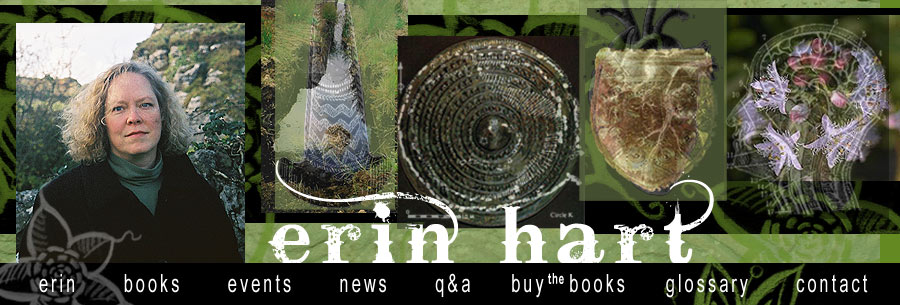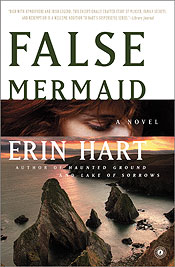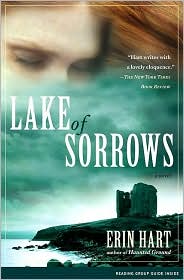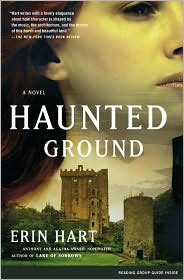skip to main |
skip to sidebar
DAY NINE
 Our last day in Ireland was spent in one of my favorite counties, Clare—aka The Banner County. We spent some time in Ennis, which is another great town for music, ducking into Custy's Music Shop, where Paddy's latest CD, Mixing the Punch, was playing on the PA system. What are the chances of that? 100%, I guess!
Our last day in Ireland was spent in one of my favorite counties, Clare—aka The Banner County. We spent some time in Ennis, which is another great town for music, ducking into Custy's Music Shop, where Paddy's latest CD, Mixing the Punch, was playing on the PA system. What are the chances of that? 100%, I guess!
We had mussels again for lunch, and stopped to see the sheela-na-gig at the church in Kilnaboy, and then caromed around the Burren for the afternoon, stopping in for a drink at Gus O'Connor's pub in Doolin, quite possibly the most famous pub in Ireland.
At the seaside in Doolin, I read aloud to the group Paddy's recent poem about Micho Russell, a great whistle player and wonderful character who embodied the spirit of West Clare music. Here's a little taste:
Four years later, I went to a seaside spot
And heard his mild way of talking
Heard him hum a few notes
Saw him feeding squawking gulls
As they fluttered and pecked on the sand.
When his inky black jacket flew open to the wind
I saw a tiny tin whistle
That stood in his inside pocket
‘Faith’n,’ he said,
‘Look how they fight with the wind!’
‘Tis God’s will they fly at all.’
‘A mistake in the making.’
‘If we pluck them for cooking,
Not worth a hazel for atin’
An air might do them good
Before we leave them alone.’
And of course, no trip to Clare is really complete without at least a perfunctory visit to Saint Brigid of the Phone Box, the holy well outside Liscannor. Beside the saint in her glass case is an underground grotto filled with holy statues and rosaries and offerings for the dead.
 After our final celebratory dinner together as a group at the Falls Hotel in Ennistymon, a few of us ventured out in the rain to local pub, where hot whiskey was the order of the day.
After our final celebratory dinner together as a group at the Falls Hotel in Ennistymon, a few of us ventured out in the rain to local pub, where hot whiskey was the order of the day.
I took this photo over my head, just where the barman was preparing the lemons, slicing them carefully and studding them with whole cloves. It turned out looking like a Flemish painting, don't you think?
DAY SEVEN
 From Galway we pressed onward into the Midlands, the next thing to heaven for bog-lovers! Started out at Clonmacnoise, an early Christian monastery with many high crosses and grave slabs, and an interpretive center that imagines life there in the eighth and ninth centuries. The site looks over the River Shannon, and the fall color was spectacular—especially the currant bushes outside the entrance. Early autumn is a great time to travel in Ireland; most heritage sites are still open, and September is (statistically speaking, of course) the least rainy time of the year.
From Galway we pressed onward into the Midlands, the next thing to heaven for bog-lovers! Started out at Clonmacnoise, an early Christian monastery with many high crosses and grave slabs, and an interpretive center that imagines life there in the eighth and ninth centuries. The site looks over the River Shannon, and the fall color was spectacular—especially the currant bushes outside the entrance. Early autumn is a great time to travel in Ireland; most heritage sites are still open, and September is (statistically speaking, of course) the least rainy time of the year.
 From Clonmacnoise we began to make our way over to Clonfert Cathedral and Clontuskert Priory, but our wonderful guide and driver Patrick pulled over when he saw a tower house and thought we might be interested in snapping a few photos. Paddy and I had visited this place, Clonony Castle, about seven years ago, when it was uninhabited and covered in graffiti. Now there was a large gate (closed, of course), but as we approached, a dog came out of the tower. And then a woman appeared, and asked, "Would you like to come inside?" Who could say no? Rebecca and her faithful Schnauzer Oscar, live in the tower; she's in the process of restoring it. The castle was once home to Mary and Elizabeth Boleyn, cousins to Queen Elizabeth I, lived out their lives here; their tombstone still stands on the castle grounds (it's now under the tree in the photo). Clonony was also occupied for a time in the early 17th century by Matthew de Renzi, a cloth merchant who was supposed to have created the first English-Irish dictionary.
From Clonmacnoise we began to make our way over to Clonfert Cathedral and Clontuskert Priory, but our wonderful guide and driver Patrick pulled over when he saw a tower house and thought we might be interested in snapping a few photos. Paddy and I had visited this place, Clonony Castle, about seven years ago, when it was uninhabited and covered in graffiti. Now there was a large gate (closed, of course), but as we approached, a dog came out of the tower. And then a woman appeared, and asked, "Would you like to come inside?" Who could say no? Rebecca and her faithful Schnauzer Oscar, live in the tower; she's in the process of restoring it. The castle was once home to Mary and Elizabeth Boleyn, cousins to Queen Elizabeth I, lived out their lives here; their tombstone still stands on the castle grounds (it's now under the tree in the photo). Clonony was also occupied for a time in the early 17th century by Matthew de Renzi, a cloth merchant who was supposed to have created the first English-Irish dictionary.

Clonfert Cathedral is in a tucked-away little village in east Galway. It has a wonderful Hiberno-Romanesque arch, with six orders of arches featuring strange human and animal heads.Some of the faces are recognizable as individuals, and some have exaggerated features, similar to carvings from Mexico and South America. When we went inside, there was some fluttering movement, almost too quick for the eye to see. At first I thought it might be a few bats from the belfry, but it turned out to be a flock of orange and brown moths.There's also a nice little mermaid carving on the wall, below a row of angels.
 Not far from Clonfert is Clontuskert Priory—you may be wondering why all these places have 'clon' in their names. It comes from the Irish word 'cluain,' which means, 'meadow.' Clonfert is actually 'cluain feartha,' which means 'meadow of the grave.' Place names in Ireland are clues to the human and natural history of a particular spot.
Not far from Clonfert is Clontuskert Priory—you may be wondering why all these places have 'clon' in their names. It comes from the Irish word 'cluain,' which means, 'meadow.' Clonfert is actually 'cluain feartha,' which means 'meadow of the grave.' Place names in Ireland are clues to the human and natural history of a particular spot.

I like to revisit Clontuskert because it was the inspiration for the excavation in HAUNTED GROUND. Cormac and Nora are working away, sifting through earth and gravel for clues to the human habitation of the place, and Cormac asks Nora to look across the fields and tell him what she can see. What she sees is this... an ancient burial mound masquerading as a hill, out in the pasture with the cows. There's also a broken Christ figure that I put in the story. Reading from the story while we're looking out over the place that inspired that very passage always gives me goosebumps.
DAY EIGHT
One of the highlights of the tour (for me!) was our visit to Locke's Distillery in Kilbeggan. It was founded in 1757, and is now a museum. The tour shows off all the old machinery and huge wooden vats, the barrel-making operation, and of course you get to sample the wares, both the un-aged clear whiskey (yikes!), and the smooth and golden finished product. There's even a challenge, to see if you can discern the difference between regular and peated whiskey (that one's a doddle!) and regular and sherry-casked. Congratulations to our friend Pat Wellingham-Jones, who won the whiskey challenge!

After Kilbeggan, we headed out to Leap Castle, which has gained a reputation as the most haunted castle in Ireland. We met Sean Ryan, the man who lives there with his family. Sean is a whistle player and storyteller, so in addition to playing a few tunes, he also gave us a bit of the castle's colorful history. Then he lit some candles and let us take them up the winding stairs to the Bloody Chapel, where one of the O'Carrolls murdered his favored elder brother, a priest, way back in the 12th century. We also heard a bit about the spirits that the Ryan family has encountered while living there over the past twenty years.

Very near to Leap Castle is a place where the road splits, and goes around a small blackthorn tree known as Saint Kieran's Bush. It's a rag or 'clootie tree,' a place where people visiting Saint Kieran's well just down the hill can make offerings or intercessions on behalf of someone who has died or is in poor health or spirits. Like other rag trees found all over Ireland, this bush is covered in bits of cloth and rags, old socks and neckties, plastic bags and key chains, rosary beads and eyeglasses and baby shoes. Each represents a wish or a prayer for some ailing person. It's a bit of pagan Celtic culture lurking under the veneer of Christianity. After seeing Saint Kieran's bush for the first time, I had to include a tree like it in LAKE OF SORROWS, which is all about the notion of sacrifice, past and present.
We arrived at our hotel (the Hodson Bay in Athlone) in late afternoon. I had cut some rushes at the cliffs at Bunglas, and after keeping them alive in bathtubs of various hotel rooms, I finally sat down before dinner and showed interested folk how to make a traditional Brigid's Cross. Many thanks to Marty Davidsohn for her scissors and yarn to tie up the ends, and to Carey Sidla McKay for sharing this photo!
 Our last day in Ireland was spent in one of my favorite counties, Clare—aka The Banner County. We spent some time in Ennis, which is another great town for music, ducking into Custy's Music Shop, where Paddy's latest CD, Mixing the Punch, was playing on the PA system. What are the chances of that? 100%, I guess!
Our last day in Ireland was spent in one of my favorite counties, Clare—aka The Banner County. We spent some time in Ennis, which is another great town for music, ducking into Custy's Music Shop, where Paddy's latest CD, Mixing the Punch, was playing on the PA system. What are the chances of that? 100%, I guess! After our final celebratory dinner together as a group at the Falls Hotel in Ennistymon, a few of us ventured out in the rain to local pub, where hot whiskey was the order of the day.
After our final celebratory dinner together as a group at the Falls Hotel in Ennistymon, a few of us ventured out in the rain to local pub, where hot whiskey was the order of the day.














